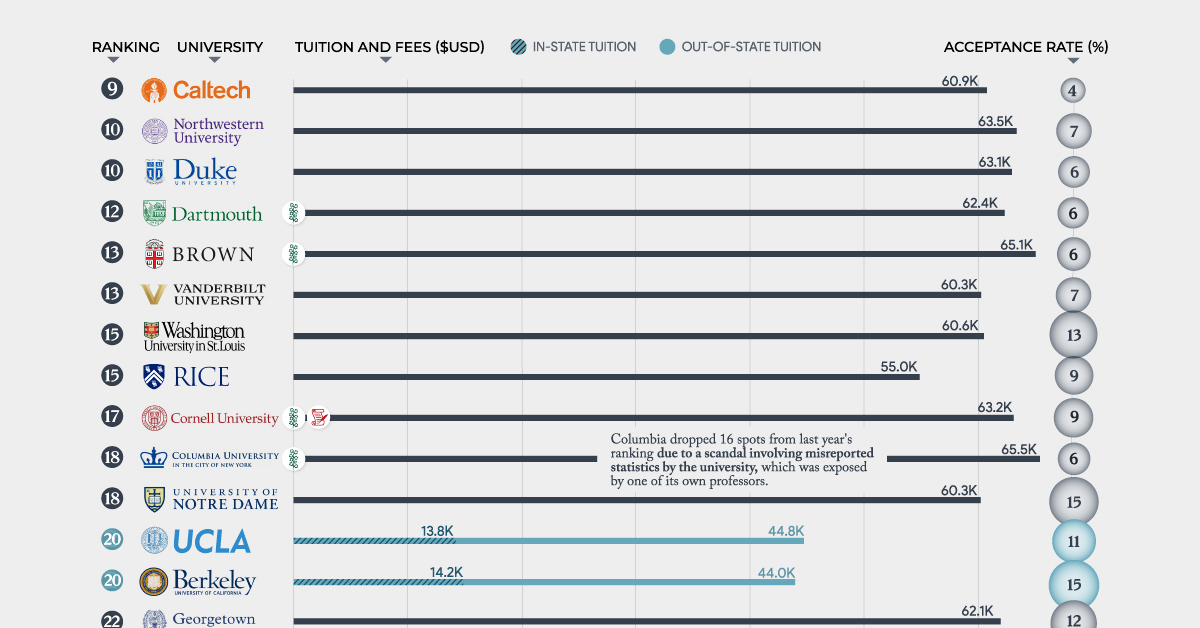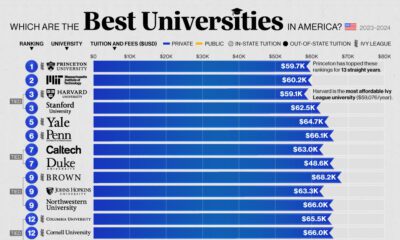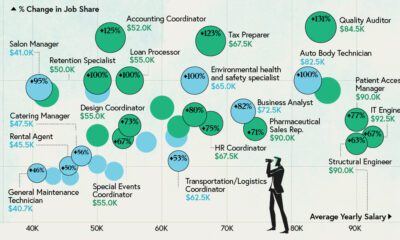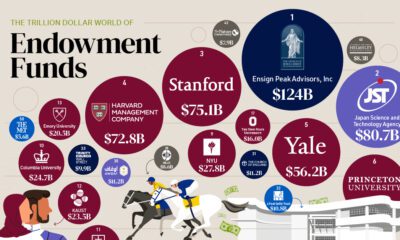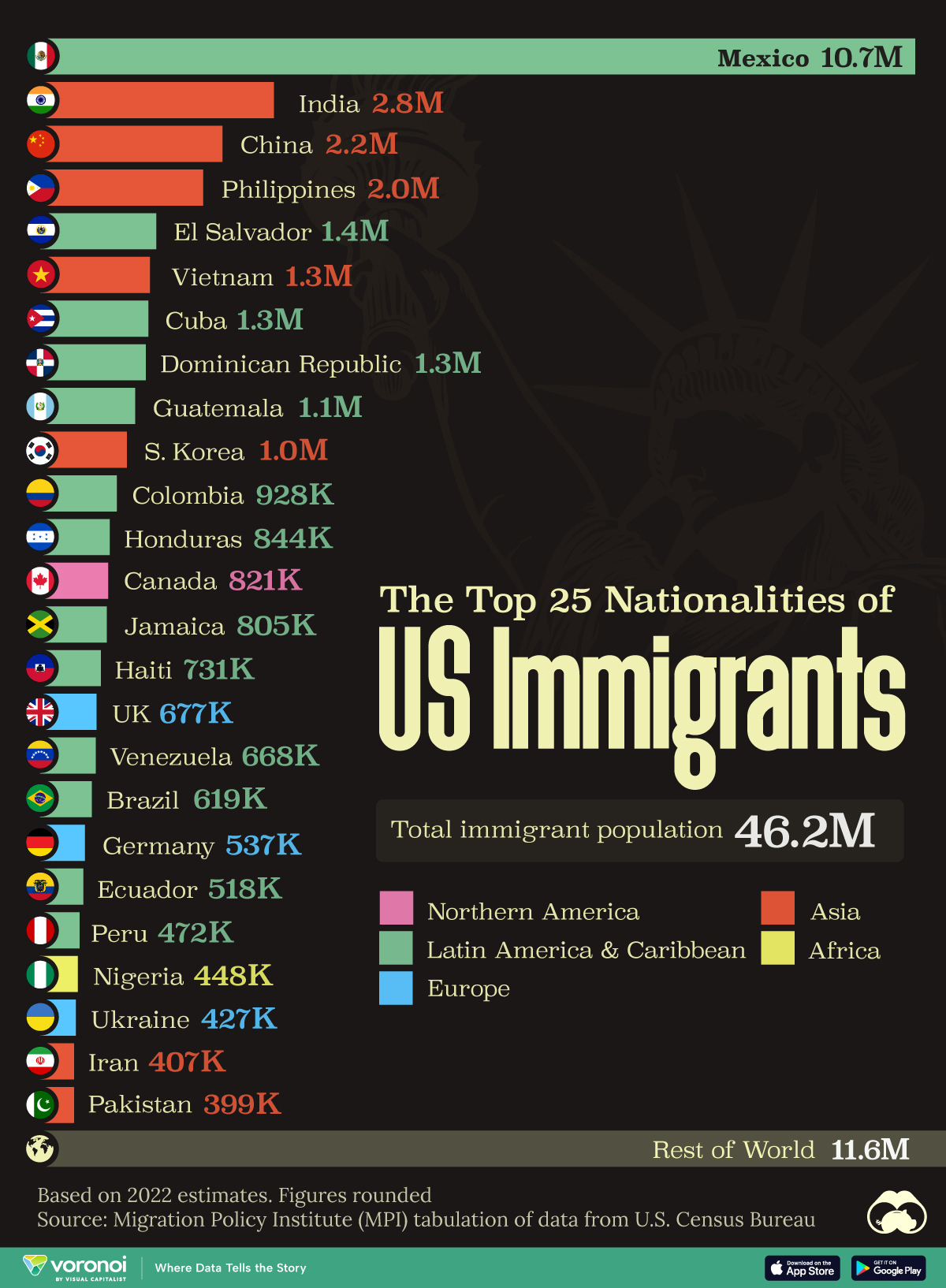Misc
Visualized: The Best Universities in America
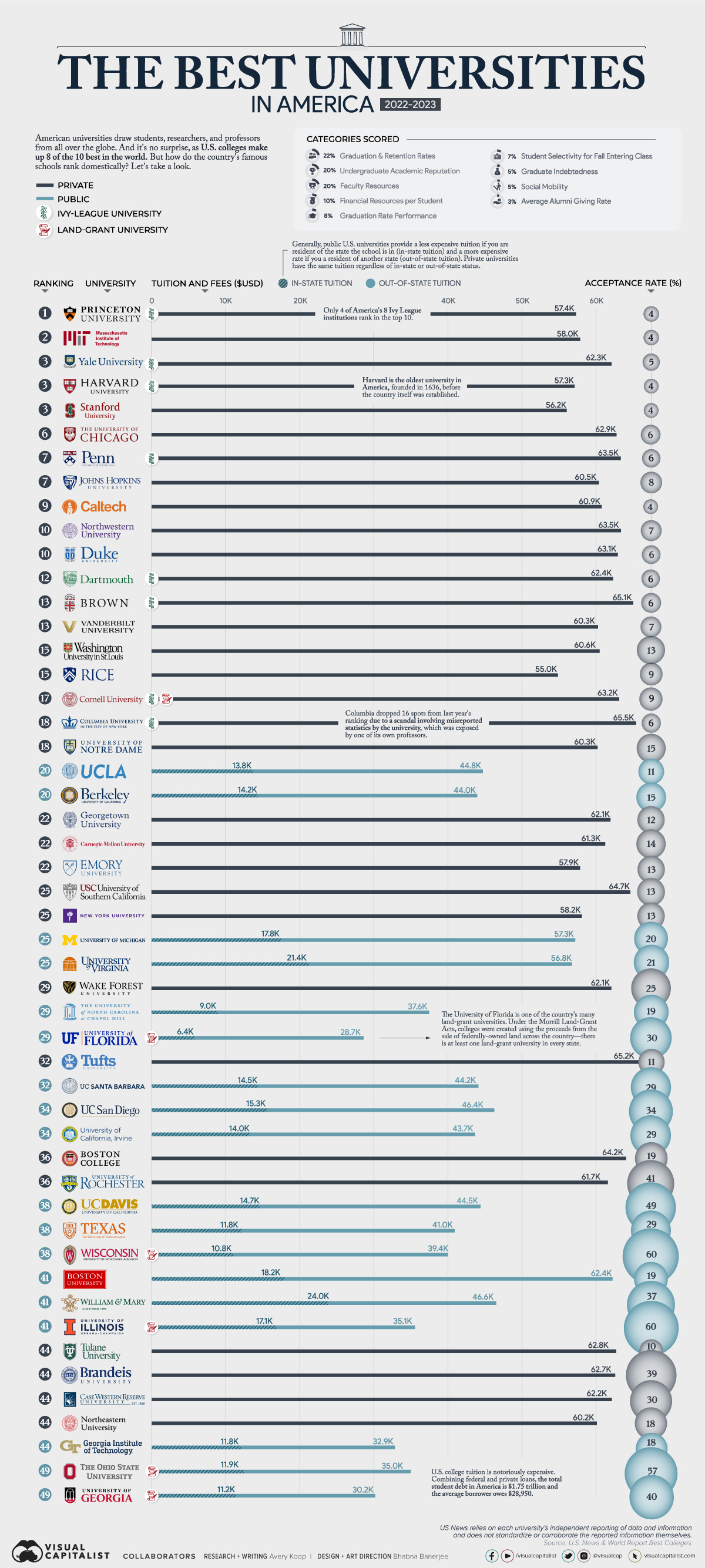
Visualized: The Best Universities in America
The United States is home to many world-class universities like Harvard, Princeton, and Yale, which boast innovative research programs, famous alumni, prestigious awards, and students and faculty from all over the world.
But which schools are actually the best ones in America?
This ranking uses data from U.S. News & World Report to rank America’s 50 best universities from the Ivy League to public institutions. Additionally, this visual shows the average tuition and acceptance rate of each school.
The Methodology
Here’s a look at how different categories are scored in the ranking. It is worth noting that U.S. News relies on each university’s independent reporting of data and information and does not standardize or corroborate the reported information themselves.
How categories are weighted:
- Graduation & Retention Rates = 22%
- Undergraduate Academic Reputation = 20%
- Faculty Resources = 20%
- Financial Resources per Student = 10%
- Graduation Rate Performance = 8%
- Student Selectivity for Fall Entering Class = 7%
- Social Mobility = 5%
- Graduate Indebtedness = 5%
- Average Alumni Giving Rate = 3%
The Top Schools
Ivy League universities are often assumed to be the top schools in America, but in reality, only four of the eight make the top 10.
Here’s a closer look:
| Rank | University | Acceptance Rate | School Type | Tuition and Fees (Private or Public Out-of-State) | In-State Tuition (Public Institutions Only) | State |
|---|---|---|---|---|---|---|
| #1 | Princeton University | 4% | Private, Ivy League | $57,410 | N/A | New Jersey |
| #2 | Massachusetts Institute of Technology | 4% | Private | $57,986 | N/A | Massachusetts |
| #3 | Yale University | 5% | Private, Ivy League | $62,250 | N/A | Connecticut |
| #3 | Harvard University | 4% | Private, Ivy League | $57,261 | N/A | Massachusetts |
| #3 | Stanford University | 4% | Private | $56,169 | N/A | California |
| #6 | University of Chicago | 6% | Private | $62,940 | N/A | Illinois |
| #7 | University of Pennsylvania | 6% | Private, Ivy League | $63,452 | N/A | Pennsylvania |
| #7 | Johns Hopkins University | 8% | Private | $60,480 | N/A | Maryland |
| #9 | California Institute of Technology | 4% | Private | $60,864 | N/A | California |
| #10 | Northwestern University | 7% | Private | $63,468 | N/A | Illinois |
| #10 | Duke University | 6% | Private | $63,054 | N/A | North Carolina |
| #12 | Dartmouth College | 6% | Private, Ivy League | $62,430 | N/A | New Hampshire |
| #13 | Brown University | 6% | Private, Ivy League | $65,146 | N/A | Rhode Island |
| #13 | Vanderbilt University | 7% | Private | $60,348 | N/A | Tennessee |
| #15 | Washington University in St. Louis | 13% | Private | $60,590 | N/A | Missouri |
| #15 | Rice University | 9% | Private | $54,960 | N/A | Texas |
| #17 | Cornell University | 9% | Private, Ivy League, Land-Grant | $63,200 | N/A | New York |
| #18 | Columbia University | 6% | Private, Ivy League | $65,524 | N/A | New York |
| #18 | University of Notre Dame | 15% | Private | $60,301 | N/A | Indiana |
| #20 | University of California, Los Angeles | 11% | Public | $44,830 | $13,804 | California |
| #20 | University of California, Berkeley | 15% | Public | $43,980 | $14,226 | California |
| #22 | Georgetown University | 12% | Private | $62,052 | N/A | District of Columbia |
| #22 | Carnegie Mellon University | 14% | Private | $61,344 | N/A | Pennsylvania |
| #22 | Emory University | 13% | Private | $57,948 | N/A | Georgia |
| #25 | University of Southern California | 13% | Private | $64,726 | N/A | California |
| #25 | New York University | 13% | Private | $58,168 | N/A | New York |
| #25 | University of Michigan--Ann Arbor | 20% | Public | $57,273 | $17,786 | Michigan |
| #25 | University of Virginia | 21% | Public | $56,837 | $21,381 | Virginia |
| #29 | Wake Forest University | 25% | Private | $62,128 | N/A | North Carolina |
| #29 | University of North Carolina at Chapel Hill | 19% | Public | $37,558 | $8,998 | North Carolina |
| #29 | University of Florida | 30% | Public, Land-Grant | $28,658 | $6,380 | Florida |
| #32 | Tufts University | 11% | Private | $65,222 | N/A | Massachussets |
| #32 | University of California, Santa Barbara | 29% | Public | $44,204 | $14,450 | California |
| #34 | University of California, San Diego | 34% | Public | $46,374 | $15,348 | California |
| #34 | University of California, Irvine | 29% | Public | $43,739 | $13,985 | California |
| #36 | Boston College | 19% | Private | $64,176 | N/A | Massachussetts |
| #36 | University of Rochester | 41% | Private | $61,678 | N/A | New York |
| #38 | University of California, Davis | 49% | Public | $44,494 | $14,740 | California |
| #38 | University of Texas at Austin | 29% | Public | $40,996 | $11,752 | Texas |
| #38 | University of Wisconsin--Madison | 60% | Public, Land-Grant | $39,427 | $10,796 | Wisconsin |
| #41 | Boston University | 19% | Public | $62,360 | $18,229 | Massachussetts |
| #41 | William & Mary | 37% | Public | $46,625 | $23,970 | Virginia |
| #41 | University of Illinois Urbana-Champaign | 6% | Public, Land-Grant | $35,110 | $17,138 | Illinois |
| #44 | Tulane University | 10% | Private | $62,844 | N/A | Louisiana |
| #44 | Brandeis University | 39% | Private | $62,722 | N/A | Massachussets |
| #44 | Case Western Reserve University | 30% | Private | $62,234 | N/A | Ohio |
| #44 | Northeastern University | 18% | Private | $60,192 | N/A | Massachusse |
| #44 | Georgia Institute of Technology | 18% | Private | $32,876 | $11,764 | Georgia |
| #49 | The Ohio State University | 57% | Private, Land-Grant | $35,019 | $11,936 | Ohio |
| #49 | University of Georgia | 40% | Private, Land-Grant | $30,220 | $11,180 | Georgia |
One of the Ivies, Columbia University, actually dropped 16 spots from last year’s ranking due to a scandal involving misreported statistics by the university, which was exposed by one of its own professors. There have been critiques of the U.S. News & World Report ranking since, as it doesn’t provide a uniform set of standards for the universities, but lets them determine how they score their categories themselves.
Among the top 10 schools admittance is very competitive, and none of the acceptance rates surpass the 7% mark. Massachusetts Institute of Technology (MIT), Stanford University, and Caltech are among the most difficult universities to get into, with only 4% of applicants receiving that exciting acceptance letter. On the flip side, the universities of Illinois and Wisconsin, for example, accept 60% of all applicants.
Types of Universities
A few more things to know—there are eight private schools in the U.S. that have earned the distinction of “Ivy League,” due to their history and prestige. A number of schools are also classified as land-grant universities—built on land which was essentially given to them by the U.S. government. This was in an effort to provide higher education to lacking communities across the country, and there is at least one in every state.
These are the U.S.’ eight Ivy League Institutions:
- Princeton University
- Yale University
- Columbia University
- Brown University
- Harvard University
- Cornell University
- Dartmouth University
- University of Pennsylvania
Beyond these prestigious academies, there are many high caliber institutions like The Ohio State University and the University of Wisconsin—both of which are land-grant universities.
Among the top 50, there are another four land-grant universities:
- University of Florida
- University of Georgia
- University of Illinois
- Cornell University
There is ripe controversy, however, surrounding land-grant universities, as, in many cases, the U.S. government funded these institutions through expropriated indigenous land.
The Cost of an American Education
U.S. college tuition is famous for being unaffordable. Combining all the federal and private loans in the country, the total student debt comes out to $1.75 trillion and the average borrower owes $28,950.
Here’s a look at how tuition breaks down on average:
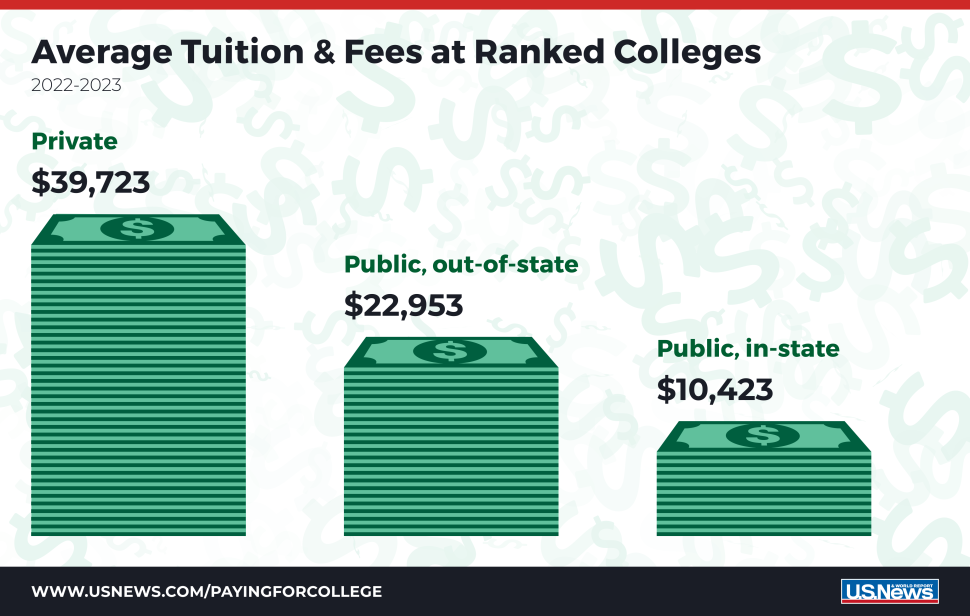
The most expensive school in America is Columbia University, with the cost of admission coming out to a whopping $65,524, with some estimates showing even higher rates for the 2022/2023 academic year. The least expensive among the top 50 is the University of Florida at $6,380 for in-state tuition—more than 10x cheaper than Columbia.
But many Americans may soon see their college loans forgiven. The Biden administration’s initiative to cancel student debt will roll out any day now and will be available on federal loans for select qualifying individuals. It has the potential to provide 40 million people with as much as $20,000 in debt forgiveness.
And given that American universities make up eight of the 10 best universities in the world, perhaps the price tag will be worth it.
Misc
The Top 25 Nationalities of U.S. Immigrants
Mexico is the largest source of immigrants to the U.S., with almost 11 million immigrants.
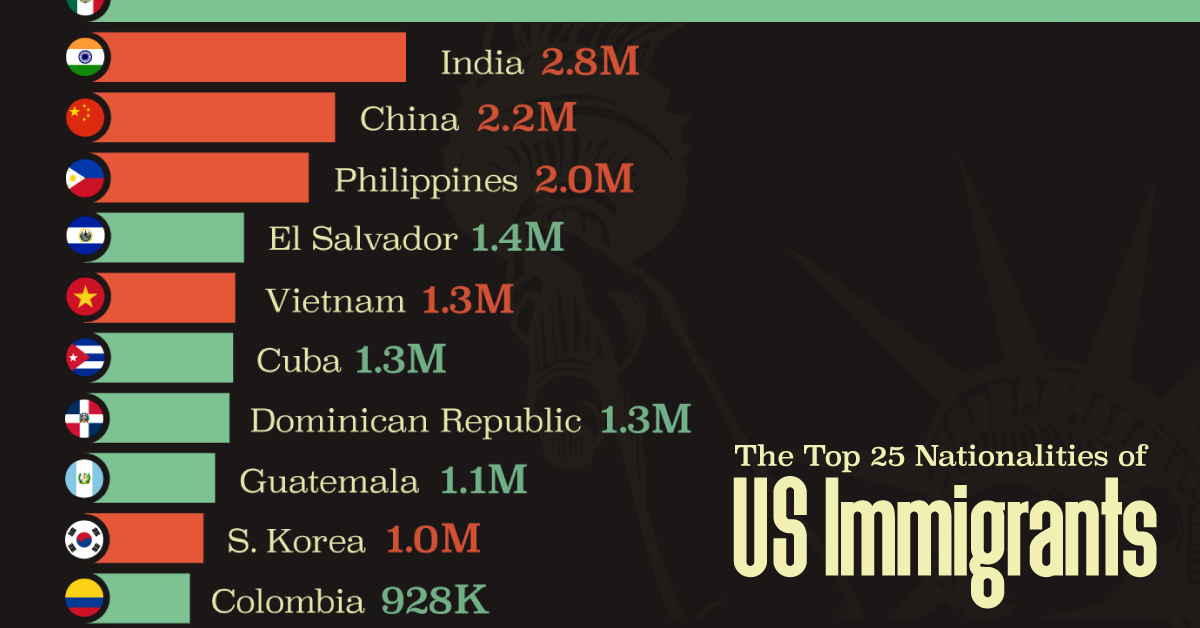
The Top 25 Nationalities of U.S. Immigrants
This was originally posted on our Voronoi app. Download the app for free on iOS or Android and discover incredible data-driven charts from a variety of trusted sources.
The United States is home to more than 46 million immigrants, constituting approximately 14% of its total population.
This graphic displays the top 25 countries of origin for U.S. immigrants, based on 2022 estimates. The data is sourced from the Migration Policy Institute (MPI), which analyzed information from the U.S. Census Bureau’s 2022 American Community Survey.
In this context, “immigrants” refer to individuals residing in the United States who were not U.S. citizens at birth.
Mexico Emerges as a Leading Source of Immigration
Mexico stands out as the largest contributor to U.S. immigration due to its geographical proximity and historical ties.
Various economic factors, including wage disparities and employment opportunities, motivate many Mexicans to seek better prospects north of the border.
| Country | Region | # of Immigrants |
|---|---|---|
| 🇲🇽 Mexico | Latin America & Caribbean | 10,678,502 |
| 🇮🇳 India | Asia | 2,839,618 |
| 🇨🇳 China | Asia | 2,217,894 |
| 🇵🇭 Philippines | Asia | 1,982,333 |
| 🇸🇻 El Salvador | Latin America & Caribbean | 1,407,622 |
| 🇻🇳 Vietnam | Asia | 1,331,192 |
| 🇨🇺 Cuba | Latin America & Caribbean | 1,312,510 |
| 🇩🇴 Dominican Republic | Latin America & Caribbean | 1,279,900 |
| 🇬🇹 Guatemala | Latin America & Caribbean | 1,148,543 |
| 🇰🇷 Korea | Asia | 1,045,100 |
| 🇨🇴 Colombia | Latin America & Caribbean | 928,053 |
| 🇭🇳 Honduras | Latin America & Caribbean | 843,774 |
| 🇨🇦 Canada | Northern America | 821,322 |
| 🇯🇲 Jamaica | Latin America & Caribbean | 804,775 |
| 🇭🇹 Haiti | Latin America & Caribbean | 730,780 |
| 🇬🇧 United Kingdom | Europe | 676,652 |
| 🇻🇪 Venezuela | Latin America & Caribbean | 667,664 |
| 🇧🇷 Brazil | Latin America & Caribbean | 618,525 |
| 🇩🇪 Germany | Europe | 537,484 |
| 🇪🇨 Ecuador | Latin America & Caribbean | 518,287 |
| 🇵🇪 Peru | Latin America & Caribbean | 471,988 |
| 🇳🇬 Nigeria | Africa | 448,405 |
| 🇺🇦 Ukraine | Europe | 427,163 |
| 🇮🇷 Iran | Middle East | 407,283 |
| 🇵🇰 Pakistan | Asia | 399,086 |
| Rest of World | 11,637,634 | |
| Total | 46,182,089 |
Mexicans are followed in this ranking by Indians, Chinese, and Filipinos, though most immigrants on this list come from countries in the Latin American and Caribbean region.
On the other hand, only three European countries are among the top sources of U.S. immigrants: the UK, Germany, and Ukraine.
Immigration continues to be a significant factor contributing to the overall growth of the U.S. population. Overall population growth has decelerated over the past decade primarily due to declining birth rates.
Between 2021 and 2022, the increase in the immigrant population accounted for 65% of the total population growth in the U.S., representing 912,000 individuals out of nearly 1.4 million.
If you enjoyed this post, be sure to check out Visualized: Why Do People Immigrate to the U.S.? This visualization shows the different reasons cited by new arrivals to America in 2021.
-

 Personal Finance1 week ago
Personal Finance1 week agoVisualizing the Tax Burden of Every U.S. State
-

 Misc7 days ago
Misc7 days agoVisualized: Aircraft Carriers by Country
-

 Culture7 days ago
Culture7 days agoHow Popular Snack Brand Logos Have Changed
-

 Mining1 week ago
Mining1 week agoVisualizing Copper Production by Country in 2023
-

 Misc1 week ago
Misc1 week agoCharted: How Americans Feel About Federal Government Agencies
-

 Healthcare1 week ago
Healthcare1 week agoWhich Countries Have the Highest Infant Mortality Rates?
-

 Demographics1 week ago
Demographics1 week agoMapped: U.S. Immigrants by Region
-

 Maps1 week ago
Maps1 week agoMapped: Southeast Asia’s GDP Per Capita, by Country




